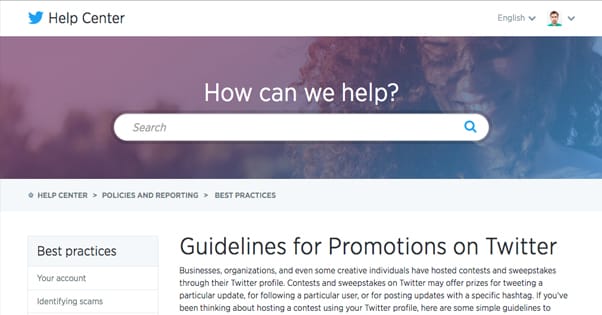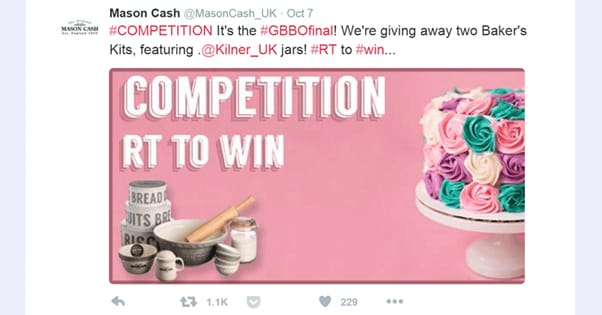For a long time, contests have been an excellent way to gain followers on social media. There was a big stink about it a few years ago, when Facebook removed the ability to like-gate content. Back then, Facebook pages would run contests with the entry locked behind liking the page. Facebook decided this was not a good way to encourage natural audience growth and removed the function.
Other social networks have not been quick to follow suit. Twitter has not blocked the feature, and it is in face part of most of the biggest and most widely used contest apps available.
You can grow your following with contests, but you need to go about it the right way. If you don’t do it properly, you might not gain any followers, you might gain irrelevant followers, or you might just have a higher cost-per-follower than just buying ads.
Learn the Twitter Contest Guidelines
Twitter has a page dedicated to their rules about promotions on Twitter, which includes contests.
I’ll sum them up for you.
- Discourage the creation of multiple accounts. Twitter recommends that you include a rule that anyone caught creating multiple accounts to get multiple entries will be ineligible to win. Twitter also reserves the right to suspend the accounts of the offending individuals.
- Discourage spam. You can have “tweet this tweet” as an entry method, but you can’t have it available every hour. There’s no hard and fast rule for how often users can post, but posting the same thing too often will filter users out of Twitter’s search, and it spams the feeds of their followers and users of the hashtags you include. Since it’s spam, it’s frowned upon.
- Encourage users to @mention you in their message. This applies only if you’re picking a user organically, not if you’re using an app. This is more of a tip for you than for your entry method, because it’s the only reliable way to see every entry without using an app to manage it all.
- Follow all applicable laws and regulations, including regulations regarding distribution of prizes, disclosure of tax information for sufficiently valuable prizes, and the posting guidelines on Twitter.
Other than the @mention rule, these are all pretty easy and common sense. They discourage exploitation while maintaining the ability of anyone eligible to enter the contest to do so. Just keep these in mind while you read the rest of this post to set up your contest.
Determine the Type of Contest
There are all sorts of different kinds of contests you can create and run on your Twitter feed. Contest apps generally have support for most of them, but you can also run them organically. Remember, contest apps simply make things easier to track and manage, they aren’t strictly necessary like they are on Facebook.
Submission contests are the most effort kind of contest, in general. It means the user has to come up with something to submit, and it means you have to go through the submissions and judge them, rather than simply pulling a name out of a hat, so to speak.
They come in all forms, such as:
- Photo contests, where you set a theme, an item, or a location and tell users to get a photograph of it. You could say “take a picture with our mascot” or “take a picture of you doing something radical with our product” or even just “take a picture you feel represents your lifestyle.”
- Caption contests, where you put forth a picture or gif and ask users to caption it. Some will write jokes, some will be serious, some will write longer stories, and it’s your job to comb through them for the best one.
- Other variants. I’ve seen brands ask for videos or vines made, I’ve seen asking for drawings or postcards, and all sorts of things.
The primary drawback to this kind of contest is the higher barrier to entry. You’ll get fewer people entering, and you need a better prize to draw them in. I know that if a contest asks me to follow an account and that’s it, I’m just going to click and move on. If they ask me to make a video, I’m going to have to really be interested in the prize to even think about pulling out a camera.
Engagement contests are similar. They require the user to do some sort of engagement with your account, but they don’t necessarily have to create anything of their own.
- Contests that require tweeting a specific phrase or retweeting a specific tweet fall into this category.
- Contests that require using a specific hashtag, regardless of the rest of the tweet, fall into this category.
- Contests that require liking a specific tweet fall into this category, though there’s no easy way to see a list of everyone who has liked a tweet without logging them as you receive the notifications.
Engagement contests have the drawback that they require the user to do something with their feed, spreading you and your contest around. If the prize is something they might not want others to know they want, or if they don’t want to “spam” a heavily curated feed, they might not be interested in entering. However, you will generally get more entries with these kinds of contests than with submission contests.
Sweepstakes are the absolute easiest to enter, and are thus the most common. You tell everyone to click a button to register their entry, then you draw a name from the hat later. You don’t need a huge prize because the entry fee is so low, so it’s really easy to run one of these. I prefer using an app for them just to track entries.
Determine the Duration of the Contest
It’s generally a good idea to have a landing page or microsite for all of your contest info, for two reasons. First, it gives you something to share rather than just explaining it all in tweets over and over. Second, it gives you more room than just the 140 characters Twitter gives you to share it.
This space should be put to good use, because you need your rules disclosure, your legal fine print, and all the rest of the info someone might need when they’re looking into your contest. If you’re harvesting emails, they want an assurance that you aren’t selling the data. You also need to determine how long you want your contest to run.
Having a fixed end date is always important, so users know when they can expect to learn if they’ve won or not. Stretch a contest on too long and people are liable to unfollow you when they don’t see closer. Keep it too short and you’re missing out on new fresh followers. In both cases, how long you let it run depends on how big a contest it is, how many people you expect to enter, and if there’s an event-based deadline of any sort.
Determine the Prize for the Contest
I mentioned this a little above, but you need to tailor your prize to the scale of the contest. If all you need to do to win a car is write your name on a slip of paper and drop it in a box, you’re going to have a million entries with very little quality control and a lot of incentive to scam the box. Conversely, if you require an elaborate video in an exotic location just to win a signed poster, it better be a damn nice poster.
You also need to tailor your prize thematically. If I were to run a contest offering a free $100 package of my service (a $100 value), the only people who would enter are the kinds of people who are likely to want my service, and who might continue on to buy more later. This is the ideal entrant; people who might shrug if they lose and go on to buy anyway, and people who, if they win, might continue to buy in the future.
On the other hand, if I run a contest giving away the new iPhone or Samsung Galaxy when it comes out, I’m going to get a huge pile of entries from people who don’t care what my business is, don’t care who I am, and will probably unfollow me within a day of the end of the contest regardless of whether they win or lose. I’ll get a lot of followers, sure, but most of them don’t care. The return on investment is zero.
It may take a little bit of trial and error to discover what you have to offer that is neither too generic nor too out of scale with your contest to be successful. You may have a few failed contests and you may give away something overly valuable for relatively little in return. However, that’s not so different from traditional advertising. You play around with targeting and ads to reach the right people, and sometimes it’s a hit, and sometimes it flops.
Pick a Method for Running the Contest
The cheapest way to run a contest is simply to put it up on Twitter and let it run. For most contests, you can monitor submissions and pick a winner at your leisure, and Twitter will allow you to track your benefits fairly reliably.
I prefer to use a contest app of some kind, however. My favorite – and one I see fairly frequently online – is Gleam. Gleam is a contest box that embeds itself on a website, in a Twitter feed, in a Facebook feed, and elsewhere. It has tracking and enforcement of contest rules, and works as a sweepstakes engine in general. You can set up specific modes of entry, including following your Twitter, retweeting a tweet, visiting a Facebook page, adding an email, and a whole lot else. This is a great way to get multiple forms of engagement out of a single person; you can get them to follow you on four services and add themselves to your mailing list all for entries in the same contest. In addition to sweepstakes and name-in-hat drawings, they work with voting contests, video competitions, photo competitions, and more.
There are, of course, many alternatives. WooBox, Wishpond, SnapApp, and more will all work if you want to use them, though they range in price considerably. I can’t imagine a small business looking to get ~100 entries to a contest is going to want to pay the $1,650 per month for SnapApp, as advanced as their platform is.
Promote Your Contest Everywhere
Once you have set up your contest and set it running, you need to promote it.
Easy mode for promotion is just sharing it on Twitter repeatedly. You can also post about it on other social networks, to get exposure and funnel people to Twitter.
Normal mode for promotion is to post about it on your website and send it out to your mailing list. You can even reach out to do some guest posting to spread it on other sites with other audiences. Pull in every form of inbound marketing channel you can access, and get people to share your contest for another entry.
Hard mode for contest promotion is doubling down on the value you get from it by paying for advertising to send more people towards it. Now, you should be careful if you go this route. It’s very easy to spend more money than you should on advertising a contest that isn’t getting you much in return. It will all really depend on how much you’re able to convert out of the people you bring in. If they’re a lot of returning customers who aren’t upgrading their service, you’re not getting new customers, and it’s not worth spending more money on. If it’s getting you a lot of fresh users, though, it could be worth it.
After that, all that’s left is to finish the contest, pick a winner, and fulfill your end of the bargain by delivering the prize.









